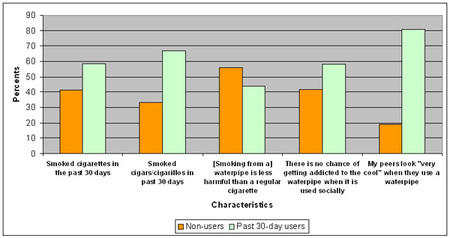The popularity of waterpipe tobacco smoking (i.e., hookah, shisha, hubble bubble, argileh), originating in Eastern Mediterranean countries, continues to grow internationally. Those using waterpipes as an alternative to standard cigarettes and cigars associate it with lower health risks (Smith-Simone, Maziak, & Ward, in press). However, these users are still ingesting tobacco, nicotine, and other associated toxins. Thus, it is important to monitor changes in waterpipe use prevalence and the long term effects such use has on both casual and regular users. Eissenberg et al. reported one of the first survey studies of a small sample of college students to explore the prevalence of waterpipe tobacco smoking (Eissenberg, Ward, Smith-Simone, & Maziak, 2008).
Participants / Methods
- Surveyed 1,194 students in an Introductory Psychology courses at Virginia Commonwealth University (VCU)
- N = 744 (62.3% response rate)
- Researchers used a cross-sectional Internet survey to gather information about students’ demographics and waterpipe use.
- Investigators also asked students to disclose information about their use, risk perceptions, influences, and perceived social acceptability of other tobacco products (e.g., cigarettes, cigars, cigarillos).
Results
- 151 participants (20.4%) reported smoking a waterpipe in the past 30 days.
- The majority of these participants (see Figure 1) also smoked cigarettes, cigars, and cigarillos during the 30 days prior to participating in this study.
- Researchers also compared perceptions between users and non-users:
- Waterpipe users were more likely to perceive waterpipe use as less harmful than cigarettes (OR = .31, CI = (.16-.58)).

Figure. Comparing characteristics of non-user and past 30-day waterpipe smokers (adapted from Eissenberg, Ward, Smith-Simone, & Maziak, 2008). Click image to enlarge.
Limitations
- The data represents a self-report survey completed on the Internet.
- The completion rate was low (37.7 % did not fill out the Internet survey).
- This student sample is a convenience sample that limits the generalizability of the results.
Discussion
Eissenberg et al. introduce worthwhile research ideas that relate directly to the effects of waterpipe tobacco smoking. Currently, researchers know that waterpipe smokers are exposed to more toxins than cigarette smokers (Shihadeh & Saleh, 2005) but the long-term health consequences have not yet been established. For example, we need to better understand the effect of waterpipe smoke on the cardiovascular system, the likelihood that waterpipe tobacco smoking causes addiction and its related problems, and the effectiveness of interventions to decrease smoking on waterpipe users. Additional research should address and clarify whether waterpipe smoking might serve as a gateway to tobacco, nicotine, and other psychoactive products because of the perception that waterpipe use is less harmful than cigarette use. All of these important areas of inquiry examining waterpipe tobacco smoking will help researchers and clinicians create, improve, and subsequently implement the right prevention methods and treatment resources.
–Ingrid R. Maurice
For more BASIS articles about waterpipe use please see:
Addictions and the Humanities, Volume 2(7) – Hooked on Hookah
References
Eissenberg, T., Ward, K. D., Smith-Simone, S., & Maziak, W. (2008). Waterpipe Tobacco Smoking on a US College Campus: Prevalence and Correlates. Journal of Adolescent Health, 42, 526-529.
Shihadeh, A., & Saleh, R. (2005). Polycycli aromatic hydrocarbons, carbon monoxide, “tar”, and nicotine in the mainstream smoke aerosol of the narghile water pipe. Food and Chemical Toxicology, 43, 655-661.
Smith-Simone, S., Maziak, W., & Ward, K. (in press). Waterpipe tobacco smoking: Knowledge, attitudes, beliefs, and behavior in two US samples. Nicotine and Tobacco Research.
What do you think? Please use the comment link below to provide feedback on this article.




